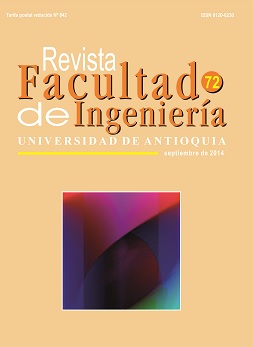Direct power control in grid-tied photovoltaic systems
DOI:
https://doi.org/10.17533/udea.redin.15041Keywords:
grid-tied photovoltaic systems, power inverters, direct power controlAbstract
This paper presents an analysis about the use of the direct power control in grid-tied photovoltaic systems. This technique is used to directly regulate the injection of instantaneous active and reactive power to the three-phase distribution network, avoiding current control loops used by traditional control strategies. The direct power control performance in photovoltaic systems is evaluated by PSIM simulation, which shows its good operation for this kind of applications. Finally, a comparative analysis is made between this controller and a traditional technique used in photovoltaic systems called voltage oriented control.
Downloads
References
A. Ipakchi, F. Albuyeh. “Grid of the Future”. IEEE Power and Energy Magazine. Vol. 7. 2009. pp. 52-62. DOI: https://doi.org/10.1109/MPE.2008.931384
S. Alepuz, S. Busquets, J. Bordonau, J. Gago, D. Gonzalez, J. Balcells. “Interfacing Renewable Energy Sources to the Utility Grid Using a Three-Level Inverter”. IEEE Transactions on Industrial Electronics. Vol. 53. 2006. pp. 1504-1511. DOI: https://doi.org/10.1109/TIE.2006.882021
L. Hassaine. “Implementación de un Control Digital de Potencia Activa y Reactiva para Inversores. Aplicación a Sistemas Fotovoltaicos Conectados a Red”. Tesis de doctorado. Universidad Carlos III de Madrid. Leganés, España. 2010. pp. 288.
M. Kazmierkowski, L. Malesani. “Current Control Techniques for Three-Phase Voltage-Source PWM Converters: a Survey”. IEEE Transactions on Industrial Electronics. Vol. 45. 1998. pp.691-703. DOI: https://doi.org/10.1109/41.720325
T. Ohnishi. Three Phase PWM Converter/Inverter by Means of Instantaneous Active and Reactive Power Control. Proceedings 1991 International Conference on Industrial Electronics, Control and Instrumentation. Vol. 1. 1991. pp. 819-824.
J. García. “Control Directo de Potencia de Convertidores Electrónicos Conectados a la Red”. Tesis de doctorado. Universidad Carlos III de Madrid. Leganés, España. 2007. pp. 176.
S. Larrinaga, M. Rodríguez, E. Oyarbide, J. Torrealday. “Predictive Control Strategy for DC/AC Converters Based on Direct Power Control”. IEEE Transactions on Industrial Electronics. Vol. 54. 2007. pp. 1261-1271. DOI: https://doi.org/10.1109/TIE.2007.893162
E. Clarke. Circuit Analysis of A-C Power Systems. Volume I Symmetrical and Related Components. 2nd ed. Ed. John Wiley & Sons, Inc. New York, USA. 1947. pp. 540.
H. Akagi, E. Watanabe, M. Aredes. Instantaneous Power Theory and Applications to Power Conditioning. Ed. John Wiley & Sons, Inc. New Jersey, USA. 2007. pp. 379. DOI: https://doi.org/10.1002/0470118938
M. Malinowski, M. Kazmierkowski, S. Hansen, F. Blaabjerg, G. Marques. “Virtual-Flux-Based Direct Power Control of Three-Phase PWM Rectifiers”. IEEE Transactions on Industry Applications. Vol. 37. 2001. pp. 1019-1027. DOI: https://doi.org/10.1109/28.936392
IEEE. “IEEE Recommended Practice for Utility Interface of Photovoltaic (PV) Systems”. IEEE Std. 929. 2000. pp. 32.
Downloads
Published
How to Cite
Issue
Section
License
Copyright (c) 2018 Revista Facultad de Ingeniería

This work is licensed under a Creative Commons Attribution-NonCommercial-ShareAlike 4.0 International License.
Revista Facultad de Ingeniería, Universidad de Antioquia is licensed under the Creative Commons Attribution BY-NC-SA 4.0 license. https://creativecommons.org/licenses/by-nc-sa/4.0/deed.en
You are free to:
Share — copy and redistribute the material in any medium or format
Adapt — remix, transform, and build upon the material
Under the following terms:
Attribution — You must give appropriate credit, provide a link to the license, and indicate if changes were made. You may do so in any reasonable manner, but not in any way that suggests the licensor endorses you or your use.
NonCommercial — You may not use the material for commercial purposes.
ShareAlike — If you remix, transform, or build upon the material, you must distribute your contributions under the same license as the original.
The material published in the journal can be distributed, copied and exhibited by third parties if the respective credits are given to the journal. No commercial benefit can be obtained and derivative works must be under the same license terms as the original work.










 Twitter
Twitter